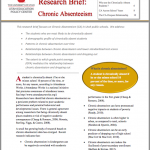
The UEPC conducted analyses of the demographic and academic correlates of chronic absenteeism in K-12.
- A student was considered chronically absent if he or she missed school 10 percent of the time, or more, for any reasons.
- Findings presented in the brief showed that:
- Homelessness and mobility were the strongest demographic predictors of chronic absenteeism.
- Chronic absenteeism was negatively correlated with student performance including reading on grade level, CRT scores, grades, and likelihood of graduating.
- The negative effects of chronic absenteeism were cumulative.
- Cross-sectional and longitudinal methods were used in this study.
